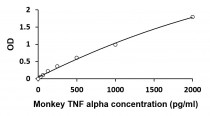ARG82817
Monkey TNF alpha ELISA Kit
Monkey TNF alpha ELISA Kit for ELISA and Monkey
Overview
| Product Description | ARG82817 Monkey TNF alpha ELISA Kit is an Enzyme Immunoassay kit for the quantification of Monkey TNF alpha in serum, plasma and cell culture supernatants. |
|---|---|
| Tested Reactivity | Mk |
| Tested Application | ELISA |
| Specificity | Cross-Reactivity: Not react with Adiponectin, ApoAI, BMP1, BMP2, BMP3, BMP4, Beta defensin 3, CCL2, CCL4, CCL5, HGF, HSP27, IL1 beta, IL2, IL4, IL5, IL6, IL7C, IL8, IL10, IL12, IL13, IL15, IL23, IFN gamma, IGF1, MMP2, MMP9, PDGF AA, PDGF BB, PDGF AB, prolactin, serpin E1, TGF beta 1, TGF beta 2, TGF beta 3, TLR1, TLR2, TLR3, TNF RI, TNFRII, sIL6R, sIL2R and VEGF. |
| Target Name | TNF alpha |
| Conjugation | HRP |
| Conjugation Note | Substrate: TMB and read at 450 nm. |
| Sensitivity | 16 pg/ml |
| Sample Type | Serum, plasma and cell culture supernatants. |
| Standard Range | 31 - 2000 pg/ml |
| Sample Volume | 100 µl |
| Precision | Intra-Assay CV: 6.0% Inter-Assay CV: 8.0% |
| Alternate Names | Tumor necrosis factor ligand superfamily member 2; DIF; Cachectin; ICD2; ICD1; N-terminal fragment; TNF-a; TNFA; TNFSF2; TNF-alpha; Tumor necrosis factor; NTF |
Application Instructions
| Assay Time | ~ 3 hours |
|---|
Properties
| Form | 96 well |
|---|---|
| Storage Instruction | Store the kit at 2-8°C. Keep microplate wells sealed in a dry bag with desiccants. Do not expose test reagents to heat, sun or strong light during storage and usage. Please refer to the product user manual for detail temperatures of the components. |
| Note | For laboratory research only, not for drug, diagnostic or other use. |
Bioinformation
| Database Links | |
|---|---|
| Gene Symbol | TNF |
| Gene Full Name | tumor necrosis factor |
| Function | Cytokine that binds to TNFRSF1A/TNFR1 and TNFRSF1B/TNFBR. It is mainly secreted by macrophages and can induce cell death of certain tumor cell lines. It is potent pyrogen causing fever by direct action or by stimulation of interleukin-1 secretion and is implicated in the induction of cachexia, Under certain conditions it can stimulate cell proliferation and induce cell differentiation. Impairs regulatory T-cells (Treg) function in individuals with rheumatoid arthritis via FOXP3 dephosphorylation. Upregulates the expression of protein phosphatase 1 (PP1), which dephosphorylates the key 'Ser-418' residue of FOXP3, thereby inactivating FOXP3 and rendering Treg cells functionally defective (PubMed:23396208). Key mediator of cell death in the anticancer action of BCG-stimulated neutrophils in combination with DIABLO/SMAC mimetic in the RT4v6 bladder cancer cell line (PubMed:22517918, PubMed:16829952, PubMed:23396208). Induces insulin resistance in adipocytes via inhibition of insulin-induced IRS1 tyrosine phosphorylation and insulin-induced glucose uptake. Induces GKAP42 protein degradation in adipocytes which is partially responsible for TNF-induced insulin resistance (By similarity). The TNF intracellular domain (ICD) form induces IL12 production in dendritic cells. [UniProt] |
| Cellular Localization | Cell membrane; Single-pass type II membrane protein. Tumor necrosis factor, membrane form: Membrane; Single-pass type II membrane protein. Tumor necrosis factor, soluble form: Secreted. C-domain 1: Secreted. C-domain 2: Secreted. [UniProt] |
| PTM | The soluble form derives from the membrane form by proteolytic processing. The membrane-bound form is further proteolytically processed by SPPL2A or SPPL2B through regulated intramembrane proteolysis producing TNF intracellular domains (ICD1 and ICD2) released in the cytosol and TNF C-domain 1 and C-domain 2 secreted into the extracellular space. The membrane form, but not the soluble form, is phosphorylated on serine residues. Dephosphorylation of the membrane form occurs by binding to soluble TNFRSF1A/TNFR1. O-glycosylated; glycans contain galactose, N-acetylgalactosamine and N-acetylneuraminic acid. [UniProt] |
Images (1) Click the Picture to Zoom In
| Title | Download Link |
|---|---|
| ARG82817 Monkey TNF alpha ELISA Kit user manual |
 Download Download
|






